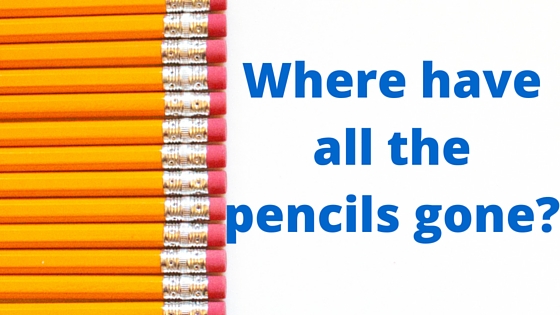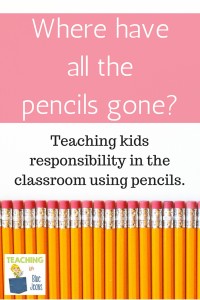Where Have All the Pencils Gone? A Very REAL Classroom Struggle!
Rewind about 4 weeks ago, I am in my classroom and about to pull my hair out as I open yet another box of pencils to sharpen. Didn’t I just do this? Yes, yes I did. I don’t know where the pencils go. My students don’t know where the pencils go. Who knows where the pencils go???? I have about decided that there is a pencil eating monster that lives in my classroom undetected. He can eat pencils in one quick bite and go undetected by the human ear or eye. Enough is enough with the pencils! I decided to try something new – my little attempt at teaching my students responsibility using their supplies and tools. Teaching responsibility does not have to be a daunting task. In fact this idea is quite simple and my students responded really well!
First I grabbed the new box of pencils and a roll of masking tape. I created a little flag on each pencil by wrapping the tape around it and then I put a number on each pencil. When my students arrived the next morning we had a little pow-wow. I told them that from now on they would have their own pencil and their job was to keep up with that pencil. (I have always been a “we share the tools in our classroom” kind of teacher). I explained what responsibility was and how they could show that they were being responsible with their pencil. I told them that they would each get a number and that the pencil would have the same number on it. I also gave them a challenge – be responsible with your pencil until Friday at lunch time and you can have lunch in the classroom.
The Responsibility Challenge
What did I mean by “be responsible” with your pencil? Well as a kindergarten teacher, I know that I can’t just leave it with that. I had to lay out my exact expectations for them. This was their responsibility challenge:
1. Keep track of your pencil and know where it is at all times (i.e. don’t lose it!)
2. Take care of it (i.e. no tearing off or chewing off the eraser)
3. Turn it in each afternoon to be sharpened for use the next day
I also explained that any pencils I found on the floor would have the number tag removed and added to the general pencil bucket. I handed out the pencils and off they went. I was impressed with how serious they became about their pencils. I often heard students reminding each other to take care of their pencils. I also saw a lot of kiddos that found a pencil (before I did) and returned it to the rightful owner using the number. But still, I wasn’t sure what the results would be.
Friday rolled around and I had 13 of my 22 kiddos eating lunch with me in the classroom! They were so excited and loved it. Yes, it was hard leaving the others in the cafeteria that day, but I knew that this was an important step in the process. After lunch on Friday we started over. Everyone got a pencil with their number on it (I only had to replace or relabel 9) and we repeated the same drill for the following week. The next Friday, 19 out of 22! Then off to spring break. I wasn’t so sure what would happen upon our return, but week 3, all 22 kiddos kept their pencil!!! Ah-May-Zing! In just 3 short weeks we went from losing a class set of pencils to using and reusing a class set of pencils! We continue to have a 95-100% success rate each week!
What if a Pencil Breaks?
If a pencil breaks, I don’t stop everything just to sharpen it. They put their pencil in the “please sharpen” bucket and grab another pencil from the “already sharp” bucket. I always keep extra pencils there for times just like this. When I have a chance, I sharpen pencils and return them to the rightful owner.
Yes, I said I sharpen pencils. After 3 years of allowing my students to sharpen their own pencils in my electric pencil sharpener, and having the pencil sharpener break before the year was over, I changed my rule. I am the only one to sharpen pencils. I do not sharpen pencils with plastic coating on them or colored pencils. Voila! No more replacing pencil sharpeners annually! During clean-up time at the end of the day, all of the pencils are put in the “please sharpen” bucket so they will be ready to go the next day. I know that this adds another task to my list, but it is a quick task and the time outweighs the expense of choosing a new pencil sharpener every year! After changing my rule – I have not replaced my pencil sharpener in over 3 years! Here’s the pencil sharpener I use and love:
I’ve also used some other tools to help my students keep track of their pencils when they are not using them. My absolute favorite was this adhesive desktop pencil holder. This picture takes you to where you can find them on Amazon, but I found mine at my local Office Max in the bins by the check-out area.
It was so easy for the kids to use it kept their pencils from rolling off their desk and onto the floor. You could also use these same adhesive holders and attach them to the wall to have a designated Pencil Station too!
I was really amazed at how well my students did with this challenge. I love that pencils aren’t disappearing any more and even more I LOVE that my kiddos are learning about responsibility. Sometimes its the little things that can make a big difference! Do you have way to teach your students responsibility? If so, please share in the comments so we can learn from each other!





My students are in high school and it might be too late for them. If I were to give them a pencil, I would need to write down the pencil number and remember to collect it from them before the end of class. I already have too much to remember and do so I have gotten to the point where I tell them I don’t have a pencil. They are forced to borrow one from a classmate. Most of the time their classmates tell them to grow up and bring their own. Some of these students are almost adults and they still lack responsibility. I just wish they learned to be responsible before hitting high school!!
Yes. Christine! I was thinking the same thing.
I teach urban middle schoolers and have spent hours in my summertime preparing my stash for the year.
Nonetheless, they lose them,break them, steal them, and jab them at one another. Then there’s the students who, when their pencils are not sharp enough to their liking, will purposefully break off the tip in order to get a sharper one.
Ideas from my past:
1)as a kid, my Dad would always get my Sister and I a fun pencil and eraser for the 1st day of school. Since my 1st day of teaching, I have done the same, but with yellow #2 pencils and an eraser topper… I tell them the story, and let them know it is the “thought” that counts that they will always come prepared. It works for a little while AND it helps me quickly assess who may be “needy,” who is irresponsible, and later, who remembers the story with compassion as tey tell new students to ask me for their “gift.”
The sentiment lasts for about the 1st quarter ♡ until old habits kick in.
2) (From another teacher) use golf pencils. Her reasoning: they don’t like to use them and will try to just use their own.
My problems with golfies: they were too short for some (still growing) big hands, they threw them as darts across the room, they left them lying around. Apathy. It sucks.
3) “Give me your I. D. in exchange for the pencil.” (Or phone, or shoe (ew!) or backpack) Problems: ew! not their phone, forgotten ids, I’m a sucker and just want them to be prepared.
4) Simply not give them one. After 14 years of teaching, I realize that I am not doing them any favors by always providing stuff that this who “ruin it for everyone else” simply take for granted.
ALSO, after having gone through multiple pencil sharpeners each year, I am done having them.
I now only have a had held sharpener periodically… if it gets lost- OH WELL. Towards the end of the year, they treasure that thing and it usually finds its way back to me. Lol
Next year I will continue with my pencil tradition, but then I will stay strong and just have to put my foot down and NOT give out pencils trough out the day.
The only THREE exceptions I’ll make is 1) for my period 1 homeroom class. My reasoning: hopefully I can get them off on the right track at the start of their day… the rest is up to them. The 2nd) exception is that I ALWAYS leave sharpened pencils for substitutes. I had been a sub. I came prepared, but I can’t expect that from a random sub. I just want to lesson the potential headaches and have some available.
The 3rd) exception: Test days. I always keep some handy in order to lower the anxiety.
Good luck. I like Amy’s tape idea, but I have over 200 students each day. I’m realistic: that won’t work…. but I like it!
Thanks for the ideas!
I actually agree with you completely. I do think that elementary and middle school are a different ball game. As kids get older I 100% believe in teaching kids responsibility. When I taught middle school I didn’t provide them with numbered pencils or a reward for keeping track of them. Sounds like you have some great procedures in place.
So do you continually have to give the lunch reward? Or once you got all students on board the reward goes away? How did you continue the responsibility?
I did lunch once a week for a couple months – then we gradually started extending the time. But I did continue to do the lunch reward by the end we did once a month. Ultimately, it becomes a habit for the kids.
I place 24 sharpened, wooden pencils in the student supply area each month. Once they are gone for the month, students have the option of borrowing a pencil from a friend or purchasing a mechanical pencil from me (for a nominal fee to reimburse me for the out of pocket cost-usually a quarter). I stock up on mechanical pencils while they are on sale.
Love this idea!! I struggled all last year with pencils. Can’t wait to try this in August!